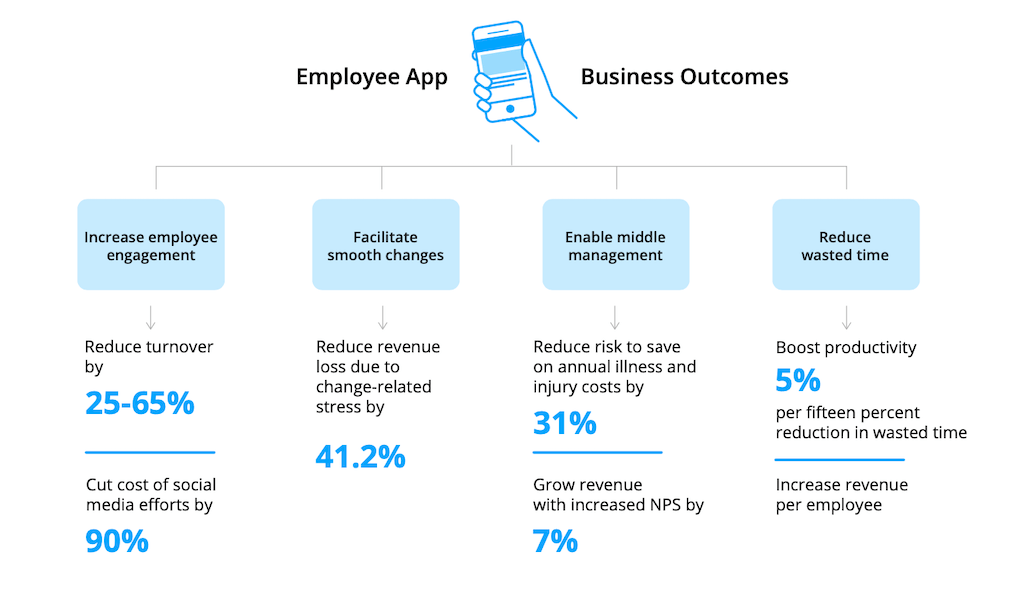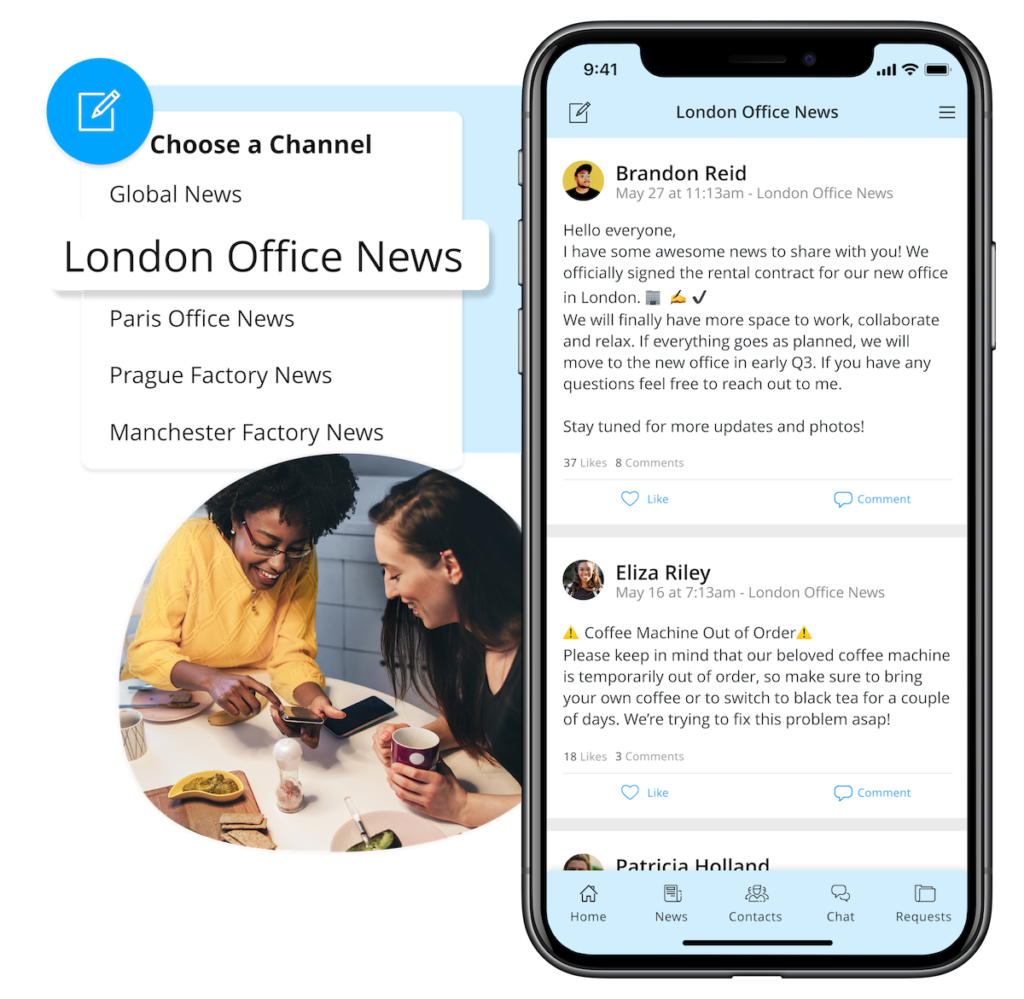10 Most Common Communication Challenges: How to Master Them with an Employee App

Effective communication is crucially important to a company’s success. It affects employee engagement, customer satisfaction, and the overall perception of an organization. That’s why internal communications software like an employee app have become an essential tool for overcoming many common internal communication challenges.
Let’s have a look at the top ten internal communication challenges and see how they can be overcome.
 The Staffbase employee app puts communication, feedback, and key resources all in one place.
The Staffbase employee app puts communication, feedback, and key resources all in one place.
1. A Lack of Feedback
If communication moves solely in one direction, information sharing will quickly become ineffective. Providing opportunities for giving feedback is key, and is important on many levels. Not only does it help determine how well your employees understand their roles and responsibilities, but it also shows how well they collaborate with their teams, their co-workers, and their managers.
Feedback also shows how well employees handle stress and adversity. A lack of feedback can lead to demotivation and depressed work attitudes. Conversely, positive feedback can make work more fun, engaging people and promoting positive development. But no matter whether feedback is good or bad, it is a necessity.
For management, getting feedback is important — but only if it’s acted upon. Surveys are useless if their results are ignored. The aim of collecting feedback should be to use it to make improvements.
Acting on the feedback we gather — adjusting our behaviors, attitudes and approaches to improve our perceptions in the workplace — is the primary differentiator between those who rise quickly through an organization and those who seem to be stuck.”
Huffington Post
No that we’ve established the importance of feedback, let’s talk about the best ways to send and receive it. The key point is to make it easy. Think of Facebook and how natural it feels to leave comments. That same intuitive flow should be embedded into your company’s communication platform. Using a simple communication tool will make providing feedback second-nature to your employees.
Also consider that just because you use SurveyMonkey doesn’t mean that your workforce feels compelled to use it. With an employee communication app, you create one main channel that requires little to no training but nonetheless provides informal feedback opportunities via likes, comments, and sharing.
2. Email Overload
In addition to phone calls, text messages, group chats, social networks, and internal meetings, an average person can receive as many as 120 emails every day. This often results in important information being lost, deleted, forgotten, or ignored amidst the noise. Employees are easily overwhelmed by overloaded inboxes. Reading through emails on a Monday morning shouldn’t feel like a climb up Mount Everest in deep winter.
Combining your existing channels into one in order to cut down on email overload is an easy way to streamline work. An employee app like Staffbase gives companies a way to avoid having to send bulk emails and instigating confusing or irrelevant “cc” conversation threads.
The emails you do send should be clear of jargon and shouldn’t invite too many people into a dialogue. Try to follow this one easy rule: Three messages max and then we talk.
3. An Overall Lack of Communication
Some of the biggest reasons why employees are dissatisfied with their jobs relate to basic internal communication challenges in the workplace: Managers who don’t provide enough information; constant changes that aren’t well communicated to employees; or people in different roles who focus solely on their own objectives, ignoring overall priorities.
Ideally, a direct line should be in place in which employees can make suggestions, share their problems, and talk about their daily workplace experiences. The Staffbase employee app enables all of this.
 The return on investment of an employee communications app: yes, there are real numbers to justify the investment into great communication teams.
The return on investment of an employee communications app: yes, there are real numbers to justify the investment into great communication teams.
Secondly, clear aims and priorities should be communicated through a range of appropriate channels. These can serve to prevent communication silos from forming and support feelings of teamwork and commonly shared goals.
Think of your employees the same way you’d think of a football team. If the players don’t know the play that’s being called, there’s no chance of advancing the ball, never mind putting points on the board.
4. Device Chaos
People tend to avoid communication if it’s happening on a device they don’t feel comfortable using. Gone are the days when people only worked on desktop computers. To ensure that information gets to your employees on the right channels, why not let them work on a device that they’re comfortable using?
Most of the time that means a smartphone. It’s the device we pick up more than 85 times a day, and it’s generally the first and last thing we look at in our waking hours. In addition, the Pew Research Center has found that 90% of our text messages are read within the first three minutes of receipt, compared to only 22% of our emails.
Solutions like the Staffbase employee app are therefore not only innovative but they’re also beloved by employees around the world. When you give your workforce the opportunity to engage and communicate on a channel that they’re already using in their daily lives, communication doesn’t seem like extra work.
5. Onboarding New Employees
While it’s always exciting to onboard new employees, the process is often cumbersome. Getting new hires up and running can take time. New hires often find themselves in a no-mans-land between their date of hire and their first day on the job. And teaching new hires about important communication techniques is sometimes an afterthought.
Since the global pandemic of 2020, even remote onboarding has become part of the new normal. Fortunately, no matter how your organization handles the process, there are many great ways an employee app can support effective onboarding.
Your aim should be to create guidelines for the onboarding process. The should be clear and easy to follow, and they should introduce your new employees to the communication methods used within your company. This way, your rookies will quickly feel like they’re part of your team and their onboarding processes will naturally introduce them to your communication flow.
Clearly–written, easily accessible manuals will also save time and ensure that every new employee receives standardized guidance throughout the onboarding process
The Staffbase app can feature manuals, including those targeted to new employees, that will automatically open as soon as they‘re given access during their pre-boarding and onboarding phases.
6. Language Barriers
While having a diverse and global workforce is something many companies actively seek and take pride in having, the resulting language barriers can be challenging.
Multi-language communication can be slow, ineffective, and sometimes nonexistent. That’s why it’s important to try and avoid misunderstandings by ensuring your news is available in multiple languages, offering easy translation options, and encouraging intercultural training.
This might sound like a lot of extra work and expense, but an employee app makes multilingual comms easy.
In addition to language barriers, cultural differences can also cause internal communication challenges in the workplace. Especially within international companies, even simple things like meetings can be the setting of misunderstandings.
Internal communication challenges differ around the globe
Consider a scenario in which a German employee has a meeting with an Indian art director. For the German, being on time will be a sign of politeness, while for the Indian, time might be more flexible — he might be half an hour late without even thinking about it.
Did you know, for example, that in China it’s polite to decline gifts three times before taking them; that in the Netherlands you have to congratulate the whole family if it’s somebody’s birthday; and that business meetings in Finland take place in saunas? Beware my friends, cultural differences abound!
An employee app like the one offered by Staffbase can make content available in more than 100 different languages. And it automatically sets itself to the language set for the device. In addition, employees can set their apps to receive locations-specific news, and they can modify these settings according to their specific needs and requirements.
7. Balancing Internal and External Comms
In order for your employees to feel engaged and to fully identify with their organization, it’s crucial that it be the main source of all company-related information. God forbid you were to file for bankruptcy and your employees found out on X. This is no less true for smaller-scale issues. Your employees should hear market or economy related news from your side first, before they hear it from anywhere else.
 Not a secret anymore: employees love local updates!
Not a secret anymore: employees love local updates!
9. A Lack of Mutual Respect and Understanding
Ideally, groups of people working together will consist of individuals from diverse backgrounds with unique experiences. On the downside, this can sometimes lead to misunderstandings if employees don’t fully respect one another or they fail to consider the range of experience outside their own from which they could likely profit.
Sharing is caring. When employees share their experiences, respect for one another grows, work environments improve, and communication automatically becomes more beneficial.
 When employees are encouraged to share their experiences, respect for one another grows.
When employees are encouraged to share their experiences, respect for one another grows.
10. Budget Constraints
Many companies and HR departments either don’t have the necessary resources for developing their own internal communication system — or they feel the benefits aren’t worth the expense. Fortunately, that’s no longer an excuse. SaaS providers like Staffbase offer effective and affordable tools for overcoming your internal communication challenges.










